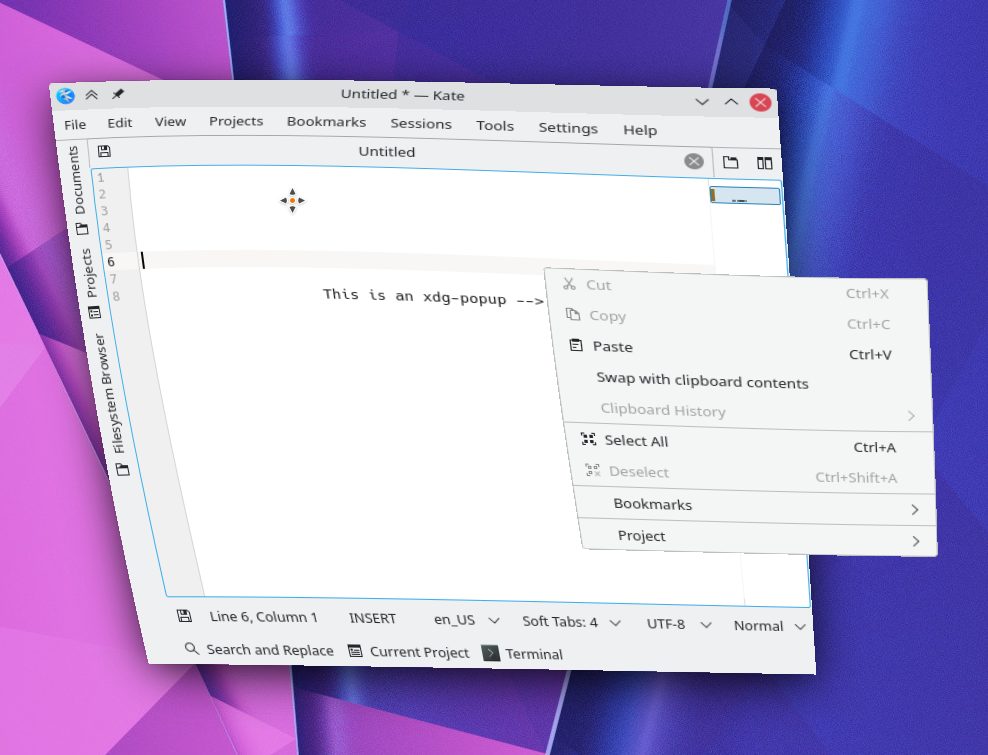
Curious Child
Last week we studied window children on X11 and Wayland at a high level. With this general knowledge acquired, we will quickly go through the recent changes to window children in KWinFT's new version.
 All the X11 Children
All the X11 Children
As mentioned in last week's article
we don't only have one kind of transient children on X11.
There are for one the usual transients,
defined by setting the WM_TRANSIENT_FOR window property to the window id of a toplevel parent window.
But there are also group transients,
defined by setting the window property to null or alternatively to the id of the root window.
 Transient Leads
Transient Leads
Normal transients and group transients were in the past handled in KWinFT by different means. In the class for managed X11 windows a field indicated that the window is a transient window. As expected for normal transients the field specified the id of the parent. For group transients it was always set to the root window id. When set to null, the window was not a transient.
Additionally there was a function mainClients()
which returned a list with all transient leads.
As a reminder these are other windows the window is a transient for.
Obviously for normal transients the returned list only contained a single element.
This has now been unified and encapsulated into a class, simply called transient, which is supposed to be composited into other classes representing windows. With that there is a single way to check if a window is a transient. And what is more important we use this same mechanism for all kinds of window children, also as seen later on Wayland.
 Around and Around
Around and Around
We said the notion of group transients increases the complexity when dealing with transient windows. One reason for that is the danger of cyclic relations.
When a window is a group transient,
other windows in the window group are transient leads for it.
This of course would lead to cyclic transient relations
when there is more than one group transient in the group.
There would also be cyclic transient relations
when one of the other windows has set a group transient
to be its transient lead in the usual way
of setting its WM_TRANSIENT_FOR window property to the other window's id.
Thinking further
this could even be the case
when there is an indirect transient relation via several windows inside or outside the group.
As we use the transient relation for stacking windows, cyclic transient relations don't make sense. Also it is likely such relations can lead to tricky bugs like infinite loops. So we should simply filter cyclic relations out.
In the old code
this was ensured through
different means.
In the new implementation we do this here nicely packed together
when updating the group or the WM_TRANSIENT_FOR value.
For all affected windows
the updated relations are saved into their composited transient class objects.
 Same but Different Wayland Children
Same but Different Wayland Children
The grand goal of this rewrite was to unify the handling of window children not only for windows on X11 but also for windows on Wayland. This has been achieved by always recurring to the same idea of window children in general, and only in detail explicitly defining what is different.
 Subsurfaces as Annexed Children
Subsurfaces as Annexed Children
In the past subsurfaces were handled in separate trees per surface. The decision to implement them this way must have seemed natural because KWin as an X11 window manager did not handle the parent-child relations of the X11 window tree. This was done, as mentioned in the previous article, by the X Server itself.
The problem with this approach is though, that we ignore that there is already a tree in the window manager, a tree for stacking all toplevel windows. We basically double the implementation cost by providing separate trees for subsurfaces. With the rewrite this has been corrected. Subsurfaces are now tracked in the same internal stack in KWinFT like all other X11 and Wayland windows. The stacking algorithm ensures that they are always above their parent surface. Input is redirected accordingly.
This greatly simplifies the handling of subsurfaces. There is one difference though. In contrast to normal X11 transient windows, subsurfaces do not have control on their own, they are no independent entities. They are rather annexed to their parent surface. It made sense to define a property named like this on its own. When painting the final image the Scene is responsible for painting subsurfaces as part of their parent surface.
 Toplevel Transients and Popups
Toplevel Transients and Popups
In the last article we saw that the xdg-shell protocol defines parent-child relations between xdg-toplevels. These relations can be represented in the same way like normal transients on X11. The implementations on Wayland and X11 are therefore very similar, only different in how the information is received via each protocol.
The case of xdg-popups is more interesting. On X11 we saw that popups are basically ignored by the window manager. But on Wayland popups need to be stacked and positioned by the window manager as there is no other entity like the X Server doing that for us.
Obviously we want to interpret them as window children again to reuse our tools. The refactored implementation was designed that way. But this is also a good example of how defining the right notion often can make all the difference as we interpret them not only as normal window children.

An effect acts on a Wayland popup as it is an annexed child.
They are now in the same way like subsurfaces set to be annexed children. This way effects affecting the parent also affect them.
 Restacked Perception
Restacked Perception
One interesting aspect of the unification work on window children is that the annexed children motivated an overhaul of the central stacking algorithm. The old algorithm was difficult to understand with several counters and nested loops. The new algorithm uses the transient class with its leads and children to compute the new stack recursively, keeping a child above its parent but below other windows.
It is therefore fair to say that in this case a different viewpoint on window children led to improvements in parts that at first seemed unrelated or at least of no concern. And this was not the only time that happened when I worked on this Windowing Revolution. In general one can say that fundamental progress is achieved when traditional views are challenged. The crucial step here was to find a new definition for unity and difference of window children.
 Roman Gilg
Roman Gilg